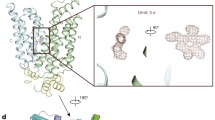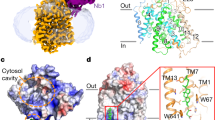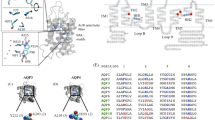Abstract
The possibility that the glucose transporter may serve as water channel is explored with the help of theoretical and experimental arguments. A model for a pore is drawn based on a hypothetical water channel structure, subject to the constraints that: molecules will bind to the channel wall in successive rings, forming a hollow sleeve; an integer number of molecules will exist in each ring; the pore radius will not be large enough to allow water molecules along its center, but will be large enough to allow glucose molecules across. The only configurations that meet these conditions exhibit either 5 or 6 water molecules abreast in each ring, with pore radii of 4.1 and 4.5 Å, respectively. The kinetic characteristics of such pores are estimated and found to conform to available evidence.
Similar content being viewed by others
References
Benga G, Popescu O, Pop VI, Holmes RP: p-(Chloromercuri)benzenesulfonate binding by membrane proteins and the inhibition of water transport in human erythrocytes. Biochem 25:1535–1538, 1986
Benga G, Popescu O, Borza G, Pop VI, Muresan A, Mocsy I, Brain A, Wrigglesworth JM: Water permeability in human erythrocytes: identification of membrane proteins involved water in transport. Europ J Cell Biol 41:252–262, 1986
Brücke E: Beiträge zur Lehre von der Diffusion tropfbarflüssiger Körper durch poröse Scheidenwände. Ann Phys Chem 58:77–94, 1843
Fischbarg J, Liebovitch LS, Koniarek JP: Inhibition of transepithelial osmotic water flow by blockers of the glucose transporter. Biochim Biophys Acta 898:266–274, 1987
Galey WR, Brahm J: The failure of hydrodynamic analysis to define pore size in cell membranes. Biochim Biophys Acta 818:425–428, 1985
Hernandez JA, Fischbarg J, Liebovitch LS: A kinetic model of single file and sleeve water transport across pores. To be published 1988
Hille B: In: Ionic channels of excitable membranes. Sinauer, Sunderland, Massachusetts, 1984, pp 201–202
Läuger P: Channels with multiple conformational states: Interrelations with carriers and pumps. In: Current Topics in Membrane and Transport. Vol. 21, Academic Press, NY, 1984, pp 309–326
Mueckler M, Caruso C, Baldwin SA, Panico M, Blench I, Morris HR, Allard WJ, Lienhard GE, Lodish HF: Sequence and structure of a human glucose transporter. Science 229:941–945, 1985
Solomon AK, Chasan B, Dix JA, Lukacovic MF, Toon AR, Verkman AS: The aqueous pore in the red cell membrane: Band 3 as a channel for anions, cations, nonelectrolytes, and water. Ann NY Acad Sci 414:97–124, 1983
Solomon AK: On the equivalent pore radius. J Memb Biol 94:227–232, 1986
Solomon AK: Characterization of biological membranes by equivalent pores. J Gen Physiol 51 (5, pt. 2):335s-364s, 1968
Stein WD: In: The Movement of Molecules across Cell Membranes. Acad Press, NY Ch. 4, 1967
Stein WD: In: Transport and Diffusion across Cell Membranes. Acad Press, NY Ch. 3, 1986
Author information
Authors and Affiliations
Rights and permissions
About this article
Cite this article
Fischbarg, J. On the possible permeation of water across the glucose transporter. Mol Cell Biochem 82, 107–111 (1988). https://doi.org/10.1007/BF00242524
Accepted:
Issue Date:
DOI: https://doi.org/10.1007/BF00242524




